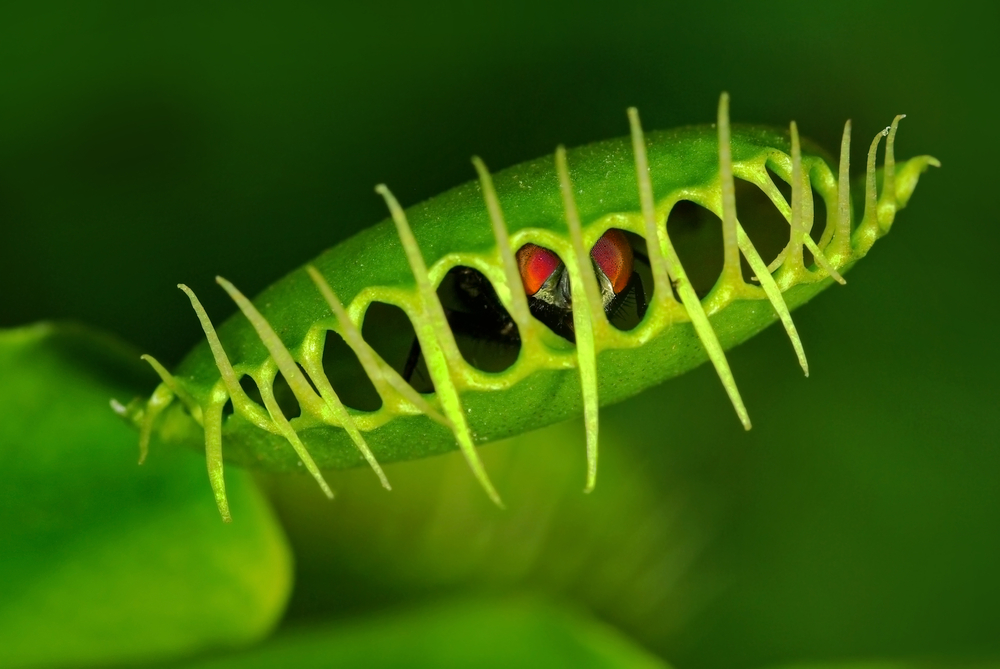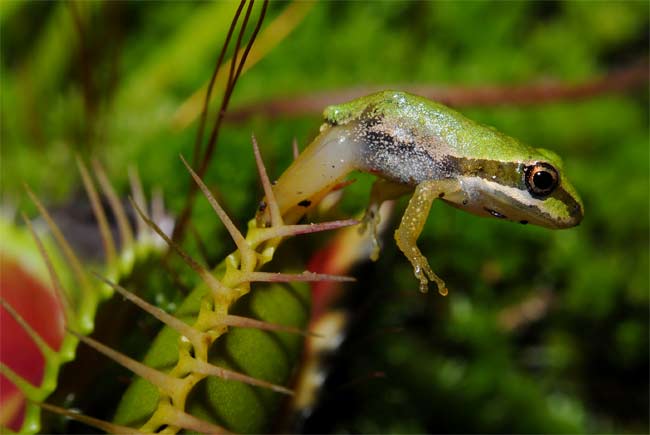How To Draw A Venus Fly Trap
Facts About Venus Flytraps
Unlike nigh plants, Venus flytraps are carnivorous, which means they swallow meat. Charles Darwin wrote in his 1875 publication, "Insectivorous Plants," that the Venus flytrap is "one of the most wonderful [plants] in the earth." There's no doubt that this stance was formed after watching the jaws of this plant snap effectually an insect, capturing it for a meal.
Size
Venus flytraps grow to around 5 inches (13 centimeters) in diameter. Each found usually has about six stems with hinged leaves. The edges of the leaves are lined with "teeth," and the leaves fit together like a clamshell. When the leaves snap close, they form a trap. An individual trap grows to effectually 1 inch (3 cm), according to The International Carnivorous Plant Society.
Habitat
Venus flytraps are native to North Carolina and South Carolina, but they have been introduced to other states, including Florida and New Jersey. They similar the moist, acidic soil institute in the understories of forests, according to the National Wildlife Federation. They also need high humidity and a lot of sunlight to flourish.
Habits & Nutrition
The most interesting matter about this plant is how it eats. Flytraps lure insects by the ruby-red lining in the leaves and past secreting a fragrant nectar. When bugs state in the jaws of the flytrap, information technology doesn't clamp down right away. Sensory hairs, chosen trichomes, on the within of the petals essentially count the movements from the insect. In that location must exist at to the lowest degree 2 movements in 20 seconds or the petals won't close. This prevents information technology from trapping debris or other items that wouldn't brand a good meal.
On the second move, the plant closes its jaws in under a 2d by snapping from a convex shape to concave shape. The bristles on the edges of the leaves work like jail confined to forbid the insect from making an escape. [Related: Deadly Math: Venus Flytraps Calculate When Killing Prey]
On the third move, information technology starts to digest the insect. Digestive juices are introduced to the mouth expanse and they break down the insect. After 5 to 12 days, the plant will reopen and the parts of the bug that couldn't exist digested fall out.
The Venus flytrap's primary casualty is ants, but it will also consume flies, beetles, slugs, spiders and even tiny frogs. Flytraps don't just consume bugs for diet, though. Like other plants, they as well need water, gases and sunlight. Insects simply supplement their diet, according to the Botanical Gild of America.

Reproduction
Venus flytraps reproduce like many other plants. When their flowers are pollinated, they create seeds. The seed mature after four to half-dozen weeks and become black and pear-shaped. These seeds are and so spread and abound into new plants.
These flytraps tin can also reproduce asexually. The roots of the Venus flytrap will extend in the soil and create a bulb root. The new flytrap will abound from the seedling. A gardener tin can then separate the new plant and bulb from the parent plant past cutting the connecting roots.
Classification/taxonomy
Hither is the taxonomy of the Venus flytrap, according to the Integrated Taxonomic Data System:
Kingdom: Plantae Subkingdom: Viridiplantae Infrakingdom: Streptophyta Superdivision: Embryophyta Division: Tracheophyta Subdivision: Spermatophytina Class: Magnoliopsida Superorder: Caryophyllanae Order: Caryophyllales Family: Droseraceae Genus: Dionaea Species: Dionaea muscipula
Conservation status
The Venus flytrap is listed as vulnerable by the International Spousal relationship for Conservation of Nature'due south Carmine List of Threatened Species. These plants are vulnerable from over-harvesting and habitat devastation.
Another trouble for flytraps is proper soil. Wood fires are sometimes benign to the understory of a forest. It tin can articulate brush and allow more sunlight through to the understory. Since woods fires are often contained and put out past humans, the trees and castor go overgrown and the Venus flytraps don't get the calorie-free they demand.

Other facts
When the flytrap's "rima oris" is closed, information technology is sealed air tight. That helps proceed out bacteria.
These are perennial plants, which ways they bloom twelvemonth after yr. Their flowers are white with green veins running from the base of the petal toward the edges, according to the National Wildlife Federation.
Information technology is estimated that Venus flytraps tin can live up to 20 years or longer, according to the National Wild animals Federation.
Additional resource
- Discovery: Venus Flytrap Catches Flies Video
- Smithsonian: The Venus Flytrap's Lethal Attraction
- Better Homes and Gardens: How to Grow Venus Flytrap
Source: https://www.livescience.com/58021-venus-flytrap-facts.html
Posted by: davisbantais.blogspot.com



0 Response to "How To Draw A Venus Fly Trap"
Post a Comment